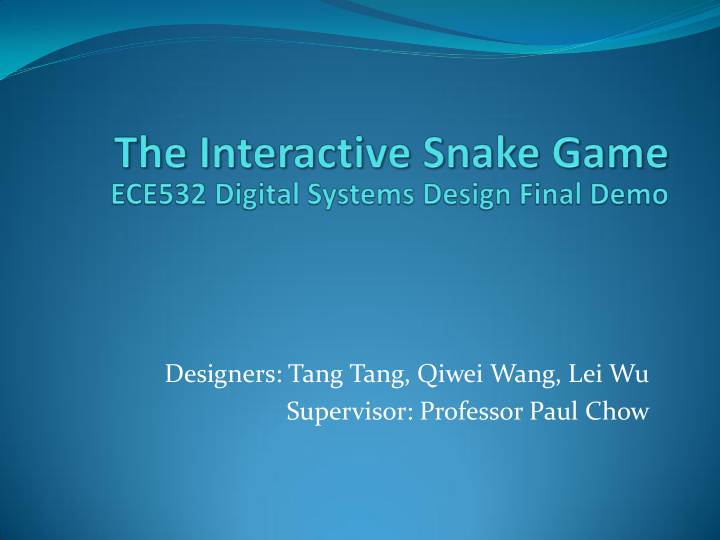



Designers: Tang Tang, Qiwei Wang, Lei Wu Supervisor: Professor Paul Chow
Project Overview Snake Classical Game + Motion Detection Xilinx XUP Virtex II Pro Development Board
Review of Project Goals Major Goals: Basic game rules (Start – Score – Game Over) Real-time detection and tracking of the beacon Real-time projection of snake body “Game Start” and “Game Over” screens Maintaining an acceptable frame rate so that the game is playable Optional Goals: Beacon location calibration Video effects, including colour and shaping of objects on screen Sound effects for events in game Increasing game difficulty × Additional obstacles on screen for increased difficulty × Difficulty level selection menu at game start screen × Numerical displaying of scoring × Automatic pause/resume when beacon is not detected
Proposed Block Diagram BRAM BRAM data instr Composite Video LMB LMB MicroBlaze UART Video Decoder Chip PLB Beacon Video To Location Speaker Ram SVGA Detector Start/End Game PLB Custom Logic Video_Out + Audio Codec (xps_tft) Legend Custom IP Memory Controller (MPMC) Existing IP Memory (DDR)
Final Block Diagram BRAM BRAM data instr Composite Video LMB LMB UART MicroBlaze (Debugging) Video GPIO to push button Decoder Chip SVGA PLB Beacon Video To Video_Out Location Speaker Ram (xps_tft) Detector GPIO PLB PLB PLB Custom Logic + Audio Codec Legend Custom IP Memory Controller Existing IP Memory (DDR)
Design Process 1) Group discussion on design requirements and system architecture 2) Partition the entire design into smaller pieces (System » Software + Hardwar » Individual blocks) 3) Specify interface for each interconnection between blocks 4) Assign blocks to individual members to work in parallel 5) Individual approach: test-driven iterative design 6) Integrating finished pieces together, testing on larger scale 7) If anything goes wrong, goes back to step 3) to check interfaces
Difficulties The EDA tools are outdated and buggy Technical issues: PLB protocol; video initialization code; out of BRAM Catch up with delayed schedule GUI and graphics are time consuming Nature of digital design: slow compilation, simulation for testing and debugging
What We Learned General approach to designing digital systems as a group Technical skills: EDA and other software, test- driven design approach, etc. Efficient time management is critical Communication is important
Acknowledgement • Professor Paul Chow • Ruediger Willenberg • All our fellow students!
Demo & Questions
Thank you!
Recommend
More recommend